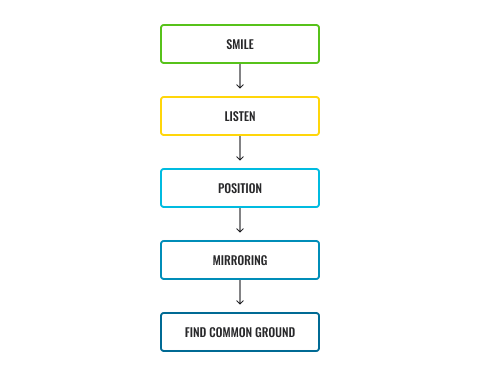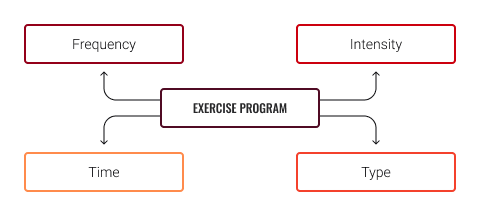In this topic, we focus on the key components for consideration when designing an exercise program for clients. You will learn about:
- Needs analysis
- FIIT
- Specificity/individualisation
- Sustainability
- Type
- Intensification principles
- Balance Planning
- performed outside of PT sessions
Terminology and vocabulary reference guide
As an allied health professional, you need to be familiar with terms associated with basic exercise principles and use the terms correctly (and confidently) with clients, your colleagues, and other allied health professionals. You will be introduced to many terms and definitions. Add any unfamiliar terms to your own vocabulary reference guide.
Activities
There are activities throughout the topic and an end of the topic automated quiz. These are not part of your assessment but will provide practical experience that will help you in your work and help you prepare for your formal assessment.

When establishing an exercise program, it is crucial that trainers base their programs on the client’s individual needs. As every client is unique, it is important to obtain relevant information from each in order to have all of the details required to produce a well-designed, safe and effective training program. It is important to be aware that each client will present with their own:
- goals
- fitness levels
- socio-economic and cultural background
- lifestyle (e.g., diet, work-life balance).
- exercise history
- medical history
- capacity to train
In short, each program should be specifically tailored to each individual clients’ needs and preferences otherwise it simply will not be effective.
The first step to developing an effective design program is to conduct the client consultation session. This session provides the opportunity to create and build rapport whilst taking the client through a series of questions to obtain personal information. It is important to note, however, that it is common that most people will not want to share their personal history with someone they have just met. Therefore, within the initial consultation process, it would also be ideal to establish professional credibility, determine compatibility and trust between yourself and your client as this will help the client feel comfortable and allow them to feel a sense of genuine interest and connection.
The personal trainer/client relationship is close, and ideally, long-term one so it is important that you spend some initial time building rapport. The following are five skills that can be used when communicating, that will enable you to build a closer rapport with your client.

The following aspects are vital and must be considered and discussed throughout the initial consultation.
Previous or current physical activity or exercise levels
Clients will have some idea of their fitness abilities and skill level, therefore, by asking questions related to their previous and current activity levels, the exercise professional can grasp an understanding of the level of physical activity required for a safe starting point. This will also provide an awareness of when it may be timely to alter exercises and progress in their training. A gradual and timely increase of cardio and resistance sessions will need to be provided to ensure the client does not injure themselves and burn out before progression is made.
Age
Whilst fitness is important at every age, the age of the client will play a role in the aspect of program design. For example, this may include the exercises selected within the program, the weights selected, the order of the exercises and where the focus of the program lies. This could be, along with being goal-orientated, paying attention to the possible need of improving quality of life, increasing the functionality behind daily living activities (DLA’s) whilst also keeping in mind the developmental stages of the human body and the stages of progression of any disclosed diseases or medical conditions.
Medical/health history
Everyone has a health history and it is important to be aware of the clients' details in full, asking all the professional questions required in order to gain a sound understanding with the goal of training each client safely and effectively. Important questions to ask may include whether they have had any previous or current illnesses or diseases, allergies, diabetes, high blood pressure, cardiac concerns, whether they are on medication or if they have had any previous injuries or surgeries. It is essential to work within the scope of practice, personal trainers do not have the qualifications to design a program for individuals with certain medical conditions without the consent or involvement from their doctor, therefore, it is important to obtain and accurately handle this information through working with other allied health professionals to ensure any major risk factors can be identified and responded to appropriately.
Time constraints including work or family commitments
By discussing time constraints, it is possible to measure the client’s self-efficacy as well as identify any related barriers to exercise. The training plan should support the client in exercising at a time that best suits them and at a frequency that is achievable. Understanding these variables can help craft a tailored training program to specifically meet their work/life balance.
Body Mass Index
Body Mass Index, also known as BMI, can be used as an indicator of body fat. Note that this measurement is calculated from weight and height alone, it does not consider factors such as tissue type, therefore this is better used within the general population rather than elite athletes. With this in mind, this measurement should be used as a guide not a diagnostic tool. Trainers may consider weight, height, body composition and circumference measurements and body compositions e.g. skin fold testing and girth measurements.
Goals and objectives
Discussing objectives is important as it supports the client to remain motivated on their end goal. Perhaps the client has an event at the end of the year that they want to get in shape for, or has had a baby and wishes to return to their pre-pregnancy weight. This is a great conversation to have as it establishes rapport, a connection, and identified motivators that may drawn upon to help the client remain engaged and goal-focused. It is also beneficial to create both short and long-term goals to include timeframes which help in achieving milestones while they work towards their final objective. Should these not be considered, it will be difficult to meet the clients’ needs effectively and will likely end up in the client discontinuing their training. Other key points to discuss during the initial consultation to obtain further details from your client may include:
- Current diet
- Affordability
- Personality type including likes and dislikes
- Preferences that the client may request.
Client consultation session skills

The consultation session provides a glimpse into the clients’ life as well as ensuring the trainer has all the information needed to design a program that is both achievable and successful.
When having this conversation with your client, the best way to gather information regarding their background would include asking a mixture of open-ended and closed-ended questions when appropriate.
Open-ended questions allow the client to answer in more detail instead of simply responding with a yes or no. This will support the trainer in gathering a more detailed response.
Examples of open-ended question include:
- Can you give me a background regarding your exercise history?
- Tell me about your expectations and what you aim to achieve from this program?
- What has led to you starting a training program now?
Examples of closed-ended questions include:
- Have you attended a gym before?
- Do you have any medical conditions?
- How often can you train?
Exercise professionals will need to use these questioning techniques to gather information regarding the clients past, present and future.
See the following examples that could be used.
Past
- Have you had any medical ailments? (if so, what and when)
- When was the last time you were involved in an exercise plan and what did that involve?
- Have you been involved in an exercise program previously? If so, what support have you had thus far?
- Were you able to achieve your fitness goals? If not, what were the barriers?
Present
- How many times per week are you currently training?
- How do you feel about your current health and fitness?
- Are you currently undergoing any form of training? If so, what training?
- Do you have any current medical conditions?
Future
- What would you like to achieve from this program?
- What are your availabilities and how often are you wanting to train?
- How important is it to meet your fitness goals and needs?
- At what time frame would you like to achieve your goal?

When considering the approach to designing an effective program, ensure the F.I.T.T principles remain at the forefront as these are the variables which will be adjusted to suit the client’s needs and skill level.
- Frequency: Frequency of exercise undertaken or how often you exercise (per week)
- Intensity: Intensity of exercise undertaken or how hard you exercise (RPE, VO2max, HRmax, HR percentage)
- Time: Time you spend exercising or how long you exercise for (session duration)
- Type: Mode of exercise undertaken or what kind of exercise you do, for example, circuit training, CrossFit, long slow distance, fartlek, High-Intensity Interval Training (H.I.I.T) and hypertrophy training.

When discussing the principle of specificity and how it is relevant to program design, it is important to remember that when a client is training in order to produce a desired result, the trainer will need to implement a training plan that consists of specific training techniques and exercises to help the client achieve their chosen goal. For example, if the client needs to focus on their flexibility, then flexibility training is a must and should be incorporated within the training plan. It is like the old saying ‘’practice makes perfect” where you must continue to practice that skill in order to get better. The training provided should mimic the actions and skills that will be needed to help achieve results. It should also progress from general training to specific training methods that target the particular skills required. Program design will likely also breakdown and combine multiple components of conditioning such as fitness, strength, power, and endurance, particularly in sports that require a wider set of skills. Netball players, for example, are constantly running, jumping, and throwing so their training must consist of various exercise variations including agility, shooting accuracy along with cardiovascular training.
Consider a marathon runner wishing to prepare for a race. They would also benefit from a specific and individually tailored program which will have them ready on race day. This program would have more of a main focus on cardiovascular and muscular endurance. Solely running on a treadmill will typically not be sufficient to prepare for a marathon as this does reflect the true conditions on the day, so it is important to include outdoor based training as their body will adapt to the stress that is placed on it and prepare their bodies to run on all types of terrain.

For many people, committing to a training program typically does not last long term. Boredom can kick in along with other demotivators and distractions which can lead to clients reducing then discontinuing their training. The important question each fitness professional should ask themselves, how can I ensure each training session is exciting and valuable to ensure the client continues working towards their goal?
Working with a personal trainer in itself can be a huge motivator for some people, however other strategies should also be implemented within the training program to support the learner (client) in remaining motivated and eager to progress. Some of these include:
- Ensure the training plan is realistic. The trainer will start off with light activity and gradually increase duration and intensity as they progress.
- Ensure the client enjoys the training exercises prepared for them. The personal trainer should tailor the training plan to suit them and what they enjoy, as well as encourage them to do exercises that work best to achieve their goals.
- Develop goals (both short and long term) that are achievable and realistic. As the client sees themselves achieving small goals, it will boost their motivation to continue.
- Enforce flexibility to cater to the client’s personal requirements. Everybody is different and their commitments may change from time to time, so being able to train at a time/location that is suitable to the client will encourage them to continue.
- No time-wasting! Minimise time-wasting and maximise results. Clients want to have effectively designed programs that provide them with the right tools to maximise results.
- Develop a positive relationship with your client where they can feel comfortable to discuss any concerns and struggles. Develop a plan that minimises the risk of injury.
- Do not overdo it. If the trainer develops a plan that consists of high intensity exercise 5 days a week, this can increase the risk of injury and become a demotivator. The training plan needs to consist of high intensity, low intensity and stretching days to support the clients rest and recovery.
The type of program planned by an exercise professional and the individual exercises within should be specific to the clients’ performance mode as well as their needs. Type is used to manipulate exercise to avoid overuse of muscles, injuries or plateaus that clients are exposed to when continually repeating similar exercises. Trainers should amend variables and provide a variety of techniques that use both small and large muscle groups.
Generally, a program could consist of the following program types:
- Flexibility/stretching exercises
- Yoga/Pilates
- Anaerobic exercises
- Sprinting exercises
- Weight training
- Circuit training/cross-training
- HIIT
- Met-con (metabolic conditioning)
- Boxing
- MMA
- SAQ
For instance, if the client is looking to improve their cardiovascular fitness, then the trainer will implement a variety of activities like walking, jogging, swimming, aerobics, and other forms of high-intensity training. Cardio is easy to change since any activity that elevates the heart rate can be considered as cardiovascular exercise. Alternatively, when planning for weight loss, exercise professionals will implement exercises that focus on large muscle groups using free-weights, machine weights and body weight exercises along with cardio. In essence, the most effective way to reduce boredom and promote adaptation to progressive overload is a well timed variation in exercises.

When creating a program for your client, there may be fantastic ideas that you would like to implement as an exercise professional, however, it is crucial to avoid overtraining as this can lead to an increased risk of injury and can create havoc on the clients emotional and physical well-being. Therefore, the program must be designed at a pace that the client can perform safely and effectively, with gradual increases to support their progression and to prevent them from plateauing.
This is where the principles of accumulation and intensification come in handy, alternating between both principles to maximise results for their clients.
The accumulation phase revolves around giving the client a break from intense training to help their body recover.
Some characteristics may include:
- higher average rep ranges
- a low moderate number of sets per exercise
- lower training intensity
- shorter rest intervals.
Intensification, on the other hand, is used to control the client's training by gradually building up the volume (the number of sets x the number of reps) whilst increasing the rest periods.
The role of the exercise professional is changing the volume of training and keeping the intensity to maintain progress. When working with a client that wants to increase strength through intensification, the program would utilise fewer sets with more weights so the client will be able to build up their strength and size.
Some examples include:
- lower average rep ranges
- moderate-high number of sets
- higher training intensity
- longer rest intervals.
If the client is requesting to build strength, a practical application of how these may work together may be to place them into phases to alternate between the two principles to allow the client to pump through strength training and then provide them with a phase where their body can recover. This will continue to allow for progression and muscle building whilst also provide room for rest and recovery.
The balance principle will dictate and support exercise professionals in creating a proportioned and balanced design plan to ultimately achieve optimal results. In order to create a balanced workout program, it must consist of three basic elements which are warm-up, conditioning (work out component) and cool down.
The Warm up is an essential program component as it helps reduce muscle soreness by ensuring they are well supplied with oxygen. It also reduces the risk of injury by elevating the heart rate and body temperature slowly to minimise the stress on the heart. One example is low-intensity cardio exercises to help prepare the cardiovascular and respiratory systems for the upcoming activity.
A post work-out cool down is just as important as a warm-up. Once the main body of the work out (conditioning component) has been completed, the heart rate remains elevated, requiring time to return to resting. Abruptly ceasing exercise may create other issues including a build-up of lactic acid, which can lead to muscle cramping and stiffness or pooling of the blood in the veins leading to damage of their structural walls.
Implementing stretching within a design program is effective as it supports in decreasing heart rate whilst also stretching muscles preparing them for rest and recovery. Depending upon the sport and or the athletes training level, stretching may be best performed in the warm up or the cool down session, or both.
Examples of cooling down practices may include:
- low-intensity exercises
- light body weight exercises including lunges and squats
- foam rolling to increase blood flow and the breakdown of lactic acid and knots within the muscle.
HBF fitness, a not-for-profit company, have developed a fabulous resource that show more examples of warm ups, cool downs and stretches that can be used within the design of your program.
In addition to the balance principle, the design program will also need to consider other forms of balance such as :
- balance between modalities of exercise types including a variety of cardio/weights training.
- muscle balance in terms of agonist/antagonist to ensure no chronic postural deficiencies are developed.

As an exercise professional, planning does not end when a design program is complete, there are other responsibilities that need to be undertaken to ensure the client is satisfied and progressing throughout their training regime. How will you know if the design program is effective? What steps would you need to take to ensure the client is working towards their goal? Were there any hiccups on the way that were overlooked and may have potentially caused regression? A health professional is responsible for monitoring the training program that has been designed for every individual client. This should be conducted through regular re-evaluation, gaining feedback from respected peers as well as practice open communication with their client on an ongoing basis. Conducting re-evaluation is beneficial as it supports ongoing improvement of the client as well as preparing the health professional to adjust and modify the program in advance to prepare for any issues or concerns that may have arisen should the initial program not have been reviewed. This process provides a sound opportunity for the exercise professional to ensure both their program and their professional conduct and training skills meet the needs of the client.
Some examples of steps which can support effective planning outside of PT sessions include:
- Checking in with the client after a session to see what they enjoyed the most and exercises they may have not enjoyed.
- Discussing on a regular basis how the client is feeling and what could be done differently to suit their needs. Perhaps the training time is no longer appropriate for them due to changes in work regime for example, which would typically require an amendment to the frequency and scheduling of their training sessions.
- Making an effort to stay in touch with your client between sessions as this can have a lasting impact on relationship and rapport. This can be done by sending encouraging emails to keep them on track.
- Discussing with respected peers the progress and design plan (keeping in mind confidentiality) to share ideas on various exercises or approaches to training to further support the client in achieving their goals.
- Taking time for self-reflection. Was there an exercise that could have been amended to suit the ability of the client? Perhaps you have noticed your client struggling with weight training. Were any difficulties identified which were a result of the verbal instructions? Was that session an example of your best work?
- Performing client evaluation through structured progress reports. These are a means of helping clients evaluate their progress and continue to focus on their goals. This could include weekly accomplishments.
- Ensuring body measurements are recorded so progress is trackable. This not only helps with preparation for future sessions but also confirms with the client that the program is working well, and their goals are in fact being met.
In this topic, we focused on the key components to be considered when designing an exercise program for clients. You learnt about:
- Needs analysis
- FIIT principles
- Specificity/individualisation
- Sustainability
- Type
- Intensification principles
- Balance
- Planning performed outside of PT sessions

